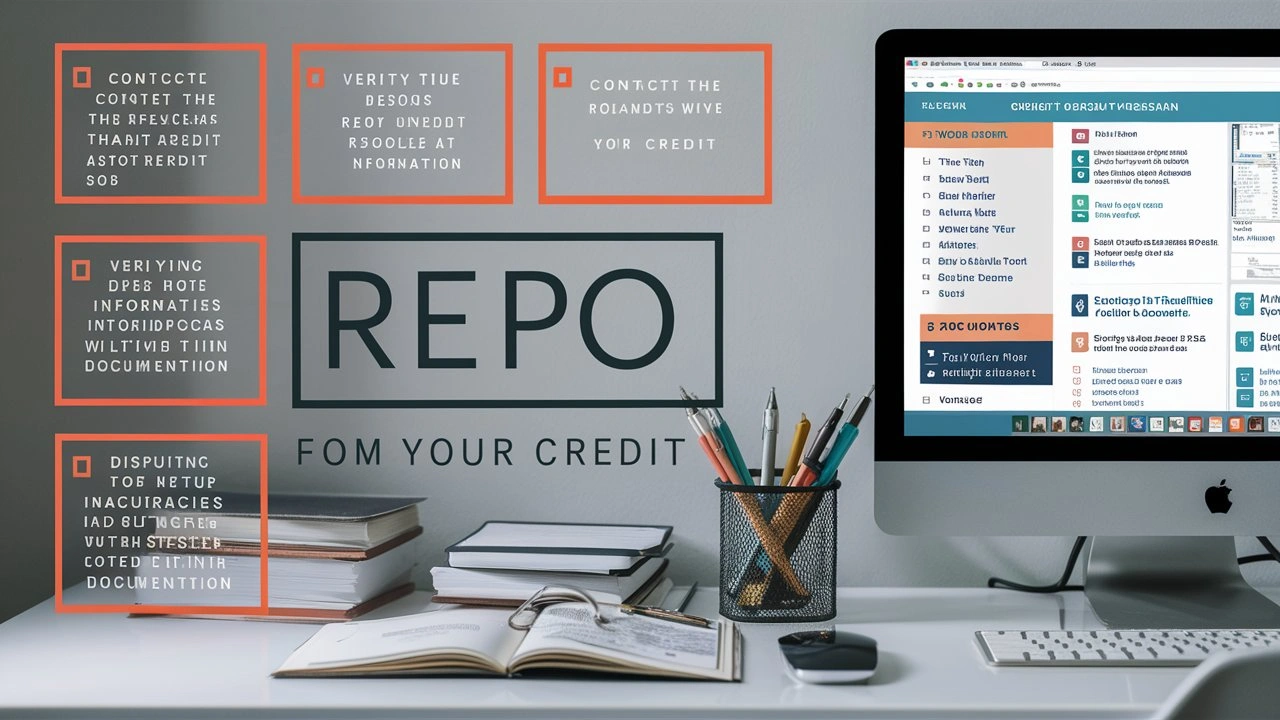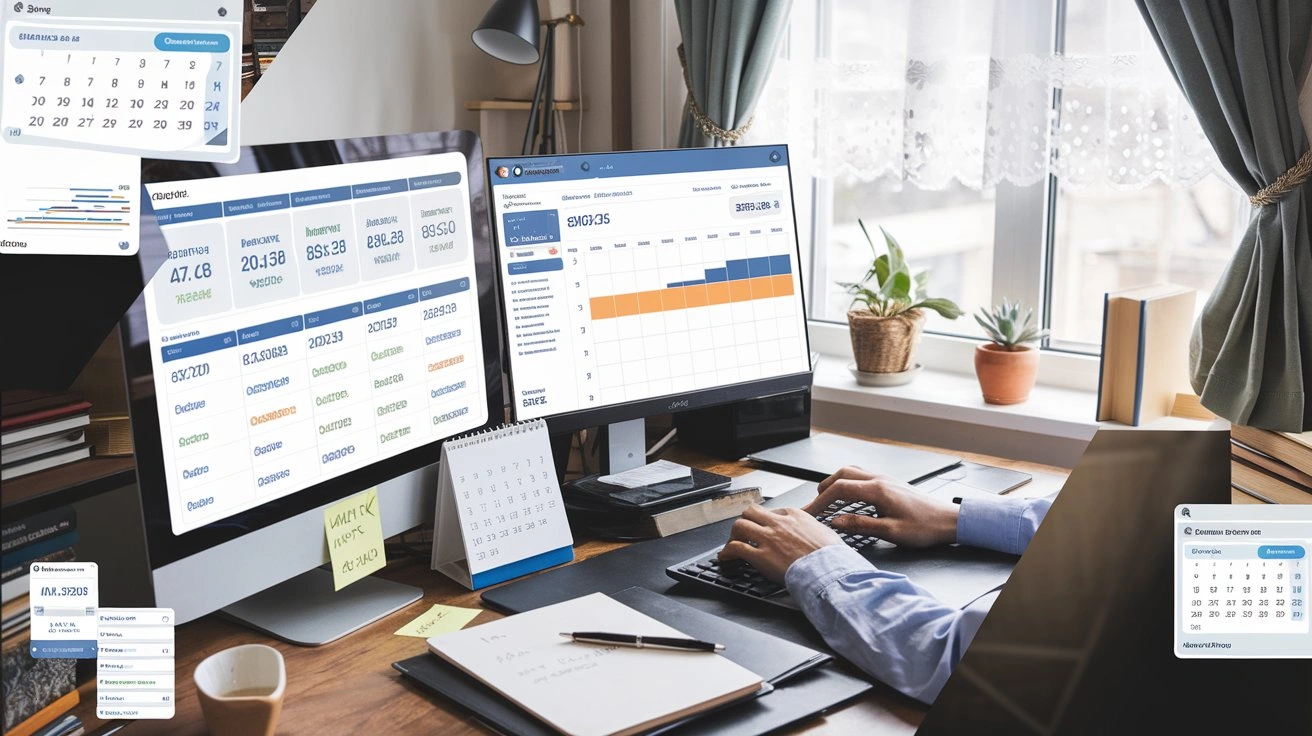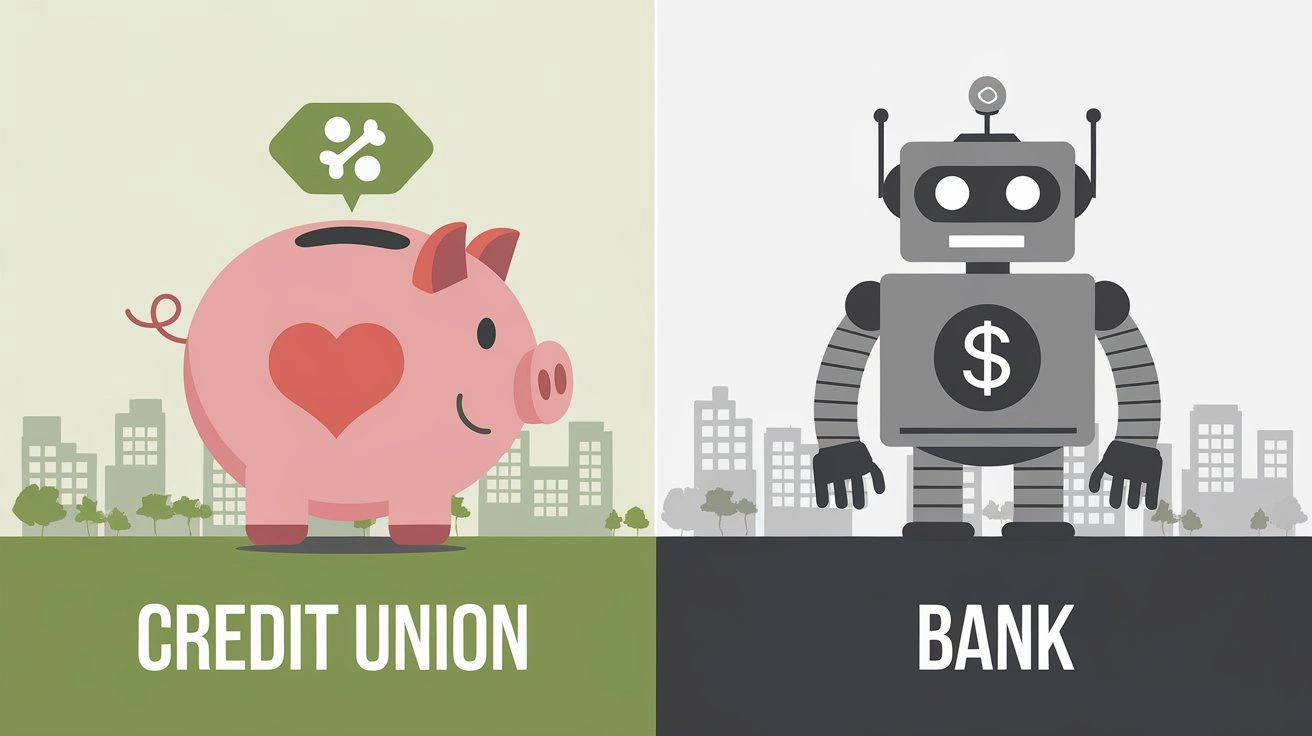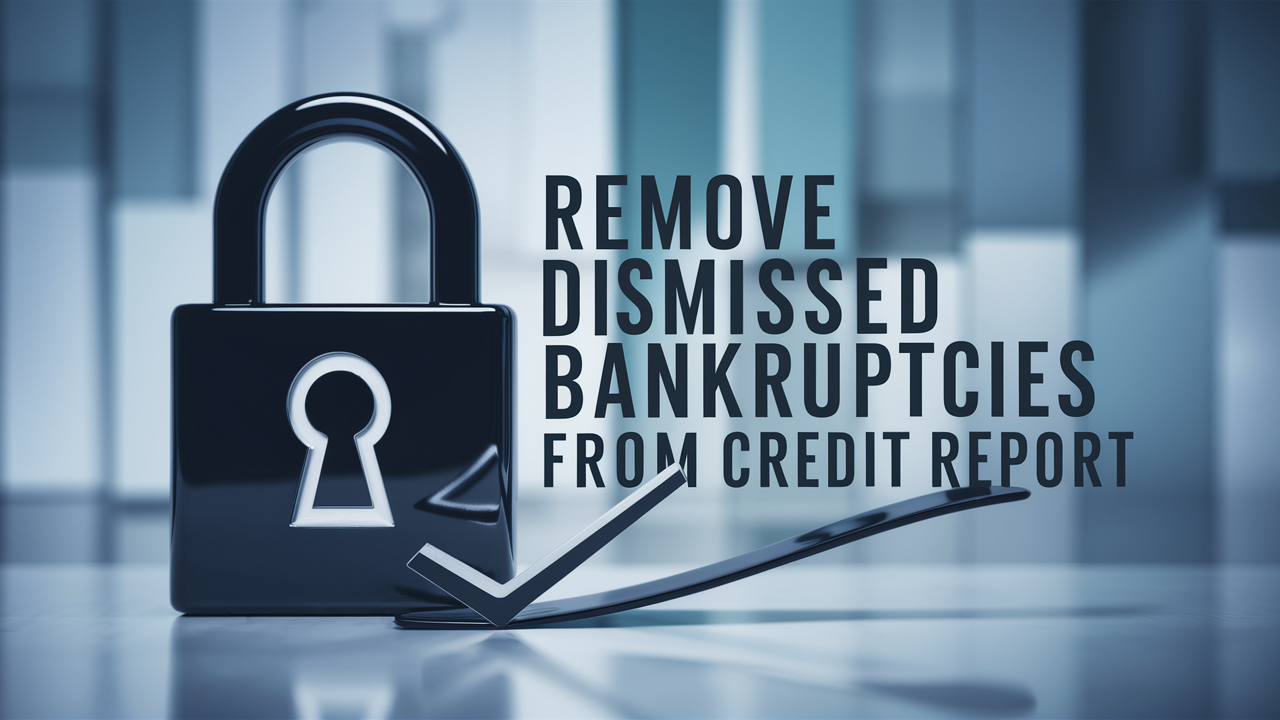How To Remove A Repo From Your Credit?

Discover how to remove a repossession from your credit report. This guide offers actionable steps and expert strategies to improve your credit score and financial future after a vehicle or property repossession. Learn your rights and effective dispute methods.
What Exactly is a Repossession and How Does it Affect Your Credit?
A repossession, often shortened to "repo," occurs when a lender takes back a secured asset, such as a car, home, or other valuable property, because the borrower has failed to make their loan payments as agreed. This is a serious consequence of defaulting on a loan. The process typically involves the lender repossessing the item, often selling it at auction to recoup their losses. If the sale proceeds are less than the outstanding loan balance, the borrower may still owe the difference, known as a deficiency balance. The impact on your credit score is profound and long-lasting. A repossession is considered a severe negative mark on your credit history, significantly lowering your credit score and making it harder to obtain new credit, secure housing, or even find employment in some industries. In 2025, the average credit score drop following a repossession can range from 50 to 150 points, depending on your score before the event and the severity of the default.
The Mechanics of Repossession
When you take out a secured loan, you pledge an asset as collateral. This means if you stop paying, the lender has a legal right to seize that asset. The specific terms and conditions are outlined in your loan agreement. Lenders are generally required to provide notice before repossessing, though the exact notification period can vary by state and loan type. Once repossessed, the item is typically sold. The Uniform Commercial Code (UCC) in many jurisdictions governs the sale of repossessed personal property, such as vehicles. For real estate, foreclosure proceedings are more complex and governed by state laws.
Financial Repercussions Beyond the Asset
The immediate financial repercussion is the loss of the asset itself. However, the damage extends far beyond that. The repossession is reported to credit bureaus (Equifax, Experian, and TransUnion) and remains on your credit report for seven years from the date of the original delinquency. This negative information can lead to:
- Significantly lower credit scores.
- Higher interest rates on future loans.
- Difficulty obtaining new loans, mortgages, or credit cards.
- Challenges in renting an apartment or home.
- Increased insurance premiums.
- Potential difficulties in employment screening.
Understanding these ramifications is the first step toward addressing the situation and seeking to mitigate its impact.
Understanding Your Credit Reports and the Impact of Repossessions
Your credit report is a detailed record of your credit history, compiled by the three major credit bureaus. It includes information about your credit accounts, payment history, outstanding debts, credit inquiries, and public records. Lenders use this report, along with your credit score, to assess your creditworthiness. A repossession is a significant negative item that can drastically alter the perception of your creditworthiness.
What Information Appears on Your Credit Report Regarding Repossession?
When a repossession is reported, it typically appears as a derogatory mark on your credit report. The entry will usually include:
- The date the account went into default.
- The name of the creditor.
- The type of loan (e.g., auto loan, mortgage).
- The status of the account (e.g., "Repossessed," "Charged Off").
- The amount of the deficiency balance, if applicable.
This information remains on your report for seven years from the date of the original delinquency, even if you pay off the deficiency balance. The presence of a repossession can lower your credit score by a substantial amount, often making it difficult to achieve a score above 600, which is often considered the threshold for subprime credit.
How Credit Scores Are Affected
Credit scoring models, like FICO and VantageScore, heavily weigh payment history and the amount of debt you carry. A repossession signifies a severe breakdown in payment history. The impact on your score depends on several factors:
- Your credit score before the repossession: Someone with a high score will likely see a more dramatic drop than someone with a lower score.
- The recency of the delinquency: More recent negative marks have a greater impact.
- The presence of other negative information: Multiple late payments or bankruptcies will exacerbate the damage.
- The amount of the deficiency balance: A large outstanding debt can further depress your score.
In 2025, data suggests that a single repossession can reduce a credit score by an average of 100 points. This makes rebuilding credit a priority after such an event.
Accessing Your Credit Reports
It is crucial to obtain copies of your credit reports from all three major bureaus to review them for accuracy. You are entitled to a free copy of your credit report from each bureau annually through AnnualCreditReport.com. Regularly checking your reports allows you to identify any inaccuracies or fraudulent activity that might be contributing to a lower score or that could be grounds for disputing the repossession itself.
Can a Repossession Be Removed From Your Credit Report? The Possibilities
The short answer is: yes, a repossession can be removed from your credit report, but it's not always straightforward. Removal typically hinges on identifying errors, negotiating with the creditor, or leveraging specific consumer protection laws. It's important to manage expectations; simply wanting it gone isn't enough. There must be a valid reason for its removal, such as factual inaccuracies or procedural violations by the lender.
When is Removal Possible?
Removal is most likely in the following scenarios:
- Factual Inaccuracies: If the repossession was reported incorrectly (e.g., wrong date, wrong amount, not your account, or if the loan was not actually repossessed).
- Procedural Errors by the Lender: If the lender did not follow proper legal procedures during the repossession or sale process, or if they failed to provide required notices.
- Settlement Agreements: In some cases, a lender might agree to remove the negative mark as part of a settlement, especially if you are paying a deficiency balance or disputing the validity of the debt.
- Statute of Limitations Expired (for reporting): While the repossession stays on your report for 7 years from the original delinquency, there are specific rules about how long a debt can be legally pursued for collection. However, this does not affect the reporting period on your credit report itself.
It is important to note that a repossession cannot be removed simply because you paid off the deficiency balance or because it has been a long time since the event, as long as it is within the 7-year reporting period and accurately reported.
The 7-Year Rule: A Common Misconception
A frequent question is whether a repossession automatically falls off after a certain period. The Fair Credit Reporting Act (FCRA) mandates that most negative information, including repossessions, can remain on your credit report for up to seven years from the date of the original delinquency. This means that even if the repossession occurred years ago, it will continue to affect your credit until that seven-year mark passes, provided it's reported accurately.
The Role of Credit Bureaus
Credit bureaus are responsible for maintaining accurate credit reports. When you dispute an item, they are required by the FCRA to investigate the claim with the creditor. If the creditor cannot verify the accuracy of the information, the credit bureau must remove it. This is the core mechanism for disputing and potentially removing a repossession.
Step-by-Step Guide: How to Remove a Repo From Your Credit
Removing a repossession from your credit report requires a systematic approach. It involves gathering documentation, understanding your rights, and communicating effectively with creditors and credit bureaus. Here’s a detailed breakdown of the steps you should take:
Step 1: Obtain and Review Your Credit Reports
Your first action should be to get copies of your credit reports from Equifax, Experian, and TransUnion. Use AnnualCreditReport.com for your free annual reports. Scrutinize each report carefully for any inaccuracies related to the repossession, such as:
- Incorrect dates of delinquency or repossession.
- Incorrect account numbers or creditor names.
- The repossession appearing on your report after the 7-year mark.
- The repossession being reported by a creditor who did not actually repossess the item.
- Discrepancies in the reported balance.
If you find any errors, document them thoroughly.
Step 2: Gather All Relevant Documentation
Collect all documents related to the loan and the repossession. This includes:
- The original loan agreement.
- Payment records showing your payment history.
- Any correspondence with the lender regarding late payments or the repossession process.
- Notice of intent to repossess (if you received one).
- Notice of sale after repossession.
- Proof of sale at auction.
- Any settlement agreements or payment plans.
- Documentation of any communications with the lender.
Having this evidence is crucial for any dispute or negotiation.
Step 3: Determine the Strategy: Dispute or Negotiate
Based on your findings, you'll decide whether to dispute the repossession as inaccurate or attempt to negotiate with the creditor.
- Dispute: If you find factual errors or believe the repossession was not handled correctly according to law, a dispute is the primary route.
- Negotiate: If the repossession is accurate but you wish to have it removed, you might try to negotiate with the creditor. This is often more challenging but can be effective if you have leverage.
Step 4: Initiate a Dispute with the Credit Bureaus
If you've identified inaccuracies, file a dispute with the credit bureau(s) reporting the incorrect information. You can do this online, by mail, or by phone. For mail disputes, send a certified letter outlining the specific inaccuracies and include copies of your supporting documentation. The FCRA requires bureaus to investigate within 30 days (or 45 days if you provide additional information after the initial dispute).
Key elements for a dispute letter:
- Your name, address, and account number (if applicable).
- A clear statement that you are disputing an item on your credit report.
- The specific item you are disputing (e.g., the repossession entry).
- The reason for the dispute (e.g., incorrect date, not your account).
- Reference to any enclosed supporting documents.
- A request for the item to be removed if it cannot be verified.
Step 5: Communicate with the Creditor
While the credit bureaus investigate, it's also wise to communicate directly with the original creditor. Send them a formal letter (certified mail is recommended) requesting validation of the debt and proof of the repossession. This is sometimes referred to as a debt validation letter, though in this context, you're seeking proof of the repossession itself and adherence to all legal processes. If they cannot provide sufficient proof or if they made procedural errors, they may agree to remove the item.
Step 6: Consider Negotiation for Removal (Pay for Delete)
In some situations, if the repossession is accurate, you might try to negotiate a "pay for delete" agreement. This involves offering to pay a portion or the full deficiency balance in exchange for the creditor agreeing to remove the repossession entry from your credit report. This is not guaranteed, as creditors are not obligated to agree to such terms. However, if the debt is old or difficult to collect, they might consider it. Get any such agreement in writing before making any payment.
Step 7: Follow Up and Monitor
After filing a dispute or sending a letter to the creditor, follow up diligently. If the credit bureaus don't respond within the stipulated timeframe or if the creditor doesn't resolve the issue, you may need to escalate. Continue to monitor your credit reports to ensure the repossession is removed if your dispute is successful. If it's not removed and you believe it should be, consider consulting a consumer protection attorney.
Disputing Errors: Your First Line of Defense
Disputing errors on your credit report is a fundamental right granted by the Fair Credit Reporting Act (FCRA). This is often the most effective way to remove a repossession if it was reported inaccurately. The process requires precision and thoroughness. By identifying and challenging inaccuracies, you can potentially clear your report of a significant negative mark.
Types of Errors to Look For
When reviewing your credit report, be vigilant for any discrepancies related to the repossession. Common errors include:
- Incorrect Dates: The date of delinquency or repossession might be wrong, potentially making the entry appear longer than it should be or fall outside the 7-year reporting limit.
- Wrong Account Information: The account number, creditor name, or loan details might be incorrect.
- Duplicate Entries: The same repossession might be listed multiple times by different creditors or bureaus.
- Incorrect Status: The account status might be misreported (e.g., showing as charged off when it was settled).
- Not Your Account: The repossession might be attributed to an account you never had.
- Reporting Beyond the 7-Year Limit: While the delinquency date dictates the 7-year window, sometimes the reporting date can be miscalculated.
- Failure to Verify: If the creditor cannot provide sufficient proof of the repossession or the debt when challenged.
How to File an Effective Dispute
To maximize your chances of success, follow these guidelines when filing a dispute:
- Be Specific: Clearly state which item on your report is incorrect and why.
- Provide Evidence: Include copies (never originals) of any documents that support your claim. This could be payment records, loan agreements, or correspondence.
- Use Certified Mail: Send your dispute letter via certified mail with a return receipt requested. This provides proof that your letter was received and when.
- Keep Records: Maintain copies of all correspondence, including your dispute letter, any response from the credit bureau, and any communication with the creditor.
- Dispute with Each Bureau: If the error appears on more than one credit report, you must file a separate dispute with each bureau that has the inaccurate information.
The Credit Bureau's Investigation Process
Once you file a dispute, the credit bureau has a legal obligation to investigate. They will typically contact the creditor (the furnisher of the information) and request verification of the disputed item. The furnisher must respond with substantiation of the information. If they fail to do so, or if the investigation reveals the information is inaccurate, the credit bureau must correct or remove the item from your report.
What If the Dispute is Unsuccessful?
If your initial dispute is denied, don't give up. You can:
- Re-dispute with New Evidence: If you find more supporting documentation, you can file a new dispute.
- Send a Consumer Statement: You can add a statement to your credit report explaining your side of the story regarding the disputed item. This statement will be included when your report is accessed by lenders.
- Escalate to the CFPB: If you believe the credit bureau or the creditor has violated your rights under the FCRA, you can file a complaint with the Consumer Financial Protection Bureau (CFPB). The CFPB is a federal agency that oversees consumer financial protection.
- Consult an Attorney: For complex cases or significant damages, consider consulting a consumer protection attorney. They can help you understand your legal options and represent you if necessary.
Negotiating with Lenders: Strategies for Removal or Mitigation
Negotiating with the lender who repossessed your asset can be a powerful strategy, especially if you cannot dispute the repossession as inaccurate. The goal here is to reach an agreement that benefits your credit standing. This often involves offering something in return for their cooperation, such as settling a deficiency balance or agreeing to specific terms.
Understanding Your Leverage
Your negotiation leverage depends on several factors:
- The Age of the Debt: Older debts may be harder for lenders to collect, giving you more negotiating power.
- The Likelihood of Collection: If the lender believes you have few assets or income to pursue for a deficiency balance, they might be more willing to negotiate.
- The Potential for Legal Action: If the lender failed to follow proper procedures, they might be motivated to settle to avoid potential legal challenges.
- Your Willingness to Pay: Demonstrating a genuine commitment to resolving the debt, even if it's a partial payment, can open doors.
Key Negotiation Tactics
When approaching the lender, be prepared and professional:
- Know the Law: Familiarize yourself with state and federal laws regarding repossessions and deficiency balances. This knowledge can inform your negotiation.
- Be Polite and Professional: Even though the situation is stressful, maintaining a calm and respectful demeanor can foster a more productive conversation.
- Propose a Settlement: If you cannot pay the full deficiency balance, offer a lump sum that is less than the total amount owed. A common starting point for negotiation is 50-70% of the balance.
- Request "Pay for Delete": As mentioned, explicitly ask if they would be willing to remove the repossession entry from your credit report in exchange for payment. Be clear that this is a condition of your payment.
- Get Everything in Writing: Any agreement reached must be documented in writing and signed by an authorized representative of the lender before you make any payment. This document should clearly state the terms of the agreement, including the removal of the negative mark from credit reports.
Settling a Deficiency Balance
If the sale of the repossessed item didn't cover the full loan amount, you'll likely owe a deficiency balance. Negotiating this balance is crucial. A successful negotiation can reduce the amount you owe, making it easier to manage. Even if the lender agrees to remove the repo from your credit, the deficiency balance might still be reported, albeit potentially as a settled account, which is less damaging than an unpaid debt.
When to Involve a Professional
If you are struggling to negotiate or if the lender is being unreasonable, consider seeking assistance from:
- Consumer Protection Attorneys: They can advise you on your rights and negotiate on your behalf.
- Credit Counseling Agencies: Reputable non-profit credit counseling agencies can help you develop a debt management plan and may offer guidance on negotiating with creditors. Be wary of for-profit debt settlement companies that make unrealistic promises.
Remember, the goal of negotiation is to find a resolution that minimizes the negative impact on your credit and financial future. Even if full removal isn't possible, settling a deficiency balance or having it reported as settled is better than an outstanding, unpaid debt.
Exploring Legal Avenues and Consumer Protection Laws
Understanding your legal rights is paramount when dealing with a repossession. Various consumer protection laws are in place to ensure lenders act fairly and legally. Violations of these laws can provide grounds for disputing the repossession or seeking damages.
The Fair Credit Reporting Act (FCRA)
As discussed, the FCRA is your primary tool for disputing inaccuracies on your credit report. It governs how credit information is collected, used, and shared. Key provisions include:
- The right to accurate credit reports.
- The right to dispute inaccurate information.
- The requirement for credit bureaus and furnishers to investigate disputes.
- Limits on how long negative information can remain on your report (generally 7 years).
If a lender or credit bureau fails to comply with the FCRA, you may have legal recourse.
The Fair Debt Collection Practices Act (FDCPA)
If a third-party debt collector is attempting to collect a deficiency balance, the FDCPA applies. This act prohibits abusive, deceptive, and unfair debt collection practices. It restricts when and how collectors can contact you, and what they can say. If the original creditor is collecting the debt themselves, the FDCPA may not apply, but some states have their own laws that offer similar protections.
State Laws Regarding Repossession and Sale
Each state has specific laws governing the repossession process and the subsequent sale of repossessed property. These laws often dictate:
- Notice Requirements: How much notice the lender must give you before repossession and before selling the item.
- Commercially Reasonable Sale: Lenders must conduct the sale in a "commercially reasonable manner." This means they cannot sell the item for significantly less than its market value without a valid reason.
- Deficiency Balance Calculation: How the deficiency balance is calculated, including any allowable fees or expenses the lender can charge.
- Right of Redemption: In some states, you may have a right to "redeem" the property by paying off the full loan balance before it's sold.
Violations of these state-specific laws can be grounds for challenging the repossession or the deficiency balance.
When to Seek Legal Counsel
Consulting with a consumer protection attorney is advisable if:
- You believe the lender did not follow proper legal procedures during the repossession or sale.
- You are being subjected to harassment or illegal debt collection practices.
- The deficiency balance appears to be unfairly calculated.
- You have attempted to dispute the repossession and have been unsuccessful.
- You are considering bankruptcy as an option.
An attorney can review your case, advise you on your rights, and help you navigate the legal system. Many offer free initial consultations.
Understanding Your Rights Regarding the Deficiency Balance
If the sale of the repossessed item yields less than what you owe, the lender can sue you for the remaining balance (the deficiency). However, they must have followed all legal procedures. If they didn't, you may have a defense against their lawsuit. Furthermore, they must give you adequate notice of the sale and conduct it in a commercially reasonable manner. If they sell it for a ridiculously low price, you may be able to argue that the deficiency amount is invalid.
Preventing Future Repossessions and Protecting Your Credit
Once you've navigated the challenging process of dealing with a repossession, the focus must shift to preventing future occurrences and rebuilding your credit. Proactive financial management and understanding credit are key to securing a stable financial future.
Strategies for Avoiding Repossession
The best way to avoid a repossession is to stay current on your loan payments. If you anticipate difficulty, act immediately:
- Communicate with Your Lender Early: If you know you'll miss a payment, contact your lender before it's due. They may offer options like a temporary deferment, a modified payment plan, or a loan modification.
- Create a Realistic Budget: Understand your income and expenses. Track your spending to identify areas where you can cut back to free up funds for loan payments.
- Build an Emergency Fund: Having savings can cover unexpected expenses (medical bills, car repairs, job loss) without derailing your ability to make loan payments. Aim for 3-6 months of living expenses.
- Avoid Taking on Too Much Debt: Be cautious about taking out new loans, especially secured ones, if your financial situation is already strained.
- Review Loan Terms Before Signing: Ensure you fully understand the interest rate, repayment schedule, and consequences of default in any loan agreement.
Rebuilding Your Credit After a Repossession
A repossession will significantly impact your credit for years. Rebuilding requires patience and consistent positive financial behavior:
- Pay All Bills On Time: Payment history is the most critical factor in credit scoring. Make every payment on time, every time.
- Reduce credit utilization: Keep your credit card balances low relative to their limits. Aim to use less than 30% of your available credit.
- Consider Secured Credit Cards: These require a cash deposit, which serves as your credit limit. They are an excellent way to build or rebuild credit when traditional cards are inaccessible.
- Become an Authorized User: If a trusted friend or family member with excellent credit adds you as an authorized user on their account, their positive payment history can benefit your credit.
- Monitor Your Credit Reports Regularly: Continue to check your reports for accuracy and to track your progress.
- Avoid New Derogatory Marks: Steer clear of any further late payments, defaults, or other negative credit events.
By 2025, lenders are increasingly using alternative data to assess creditworthiness, but a clean credit report remains foundational. Focus on establishing a consistent history of responsible credit management.
Understanding the Long-Term Impact
While a repossession is a severe blow, it doesn't have to define your financial future. The key is to learn from the experience, take steps to repair the damage, and implement habits that prevent recurrence. The seven years it remains on your report is a long time, but positive actions taken now will begin to outweigh its negative influence over time. Focus on building a strong credit profile for the future.
Timeline and Realistic Expectations for Repo Removal
Understanding the timeline and setting realistic expectations is crucial when aiming to remove a repossession from your credit report. The process is rarely instantaneous and often requires persistence.
Typical Timeline for Dispute Resolution
When you file a dispute with a credit bureau:
- Initial Investigation: The FCRA gives credit bureaus 30 days to investigate your dispute. This can be extended to 45 days if you provide additional information after the initial dispute.
- Creditor Response: During this period, the credit bureau contacts the creditor (the furnisher of the information) to verify the accuracy of the disputed item.
- Resolution: The credit bureau will then notify you of the outcome. If the item is found to be inaccurate or cannot be verified, it must be corrected or removed.
This means a successful dispute could take anywhere from a few weeks to over a month. If the credit bureau fails to act or the creditor provides insufficient verification, further action may be necessary.
Negotiation Timelines
Negotiating with a lender can vary significantly:
- Initial Contact: It might take a few days to get in touch with the right person and arrange a discussion.
- Negotiation Process: Reaching an agreement could take days or weeks, depending on the complexity of the situation and the willingness of both parties.
- Implementation: Once an agreement is reached (e.g., a pay-for-delete), it can take another billing cycle or two for the changes to be reflected on your credit report.
Realistic Expectations
- Not Guaranteed: Removal is not guaranteed. It depends heavily on the presence of errors, lender cooperation, or legal violations.
- Patience is Key: The process can be slow. You may need to follow up multiple times and be prepared for setbacks.
- Accuracy is Paramount: If the repossession is accurate and legally reported, it will likely remain on your report for the full seven years from the date of the original delinquency.
- Focus on Mitigation: If full removal isn't possible, focus on mitigating the damage by settling any deficiency balance, ensuring it's reported as settled, and diligently building positive credit history.
- Cost Considerations: While many dispute processes are free, legal assistance or debt settlement services may incur costs. Weigh these against the potential benefits.
By 2025, the credit landscape continues to evolve, but the fundamental principles of accuracy and diligent consumer action remain. Stay informed, be persistent, and focus on positive financial habits to overcome the challenge of a repossession.
In conclusion, removing a repossession from your credit report is a challenging but achievable goal. It requires a thorough understanding of your credit reports, your rights under consumer protection laws, and a strategic approach to disputing errors or negotiating with creditors. By meticulously gathering documentation, filing accurate disputes, and persistently following up, you significantly increase your chances of success. Remember that patience and a commitment to positive financial behavior are your greatest allies in this process. Even if immediate removal isn't possible, mitigating the damage and rebuilding your credit score through consistent on-time payments and responsible credit management will pave the way for a healthier financial future. Take control of your credit narrative starting today.
Related Stories
Recent Posts
How to Choose a Credit Repair Company in 2026
Does Closing a Checking Account Affect Your Credit Score? Here’s the Truth
Is a Home Equity Loan a Second Mortgage? The Definitive 2025 Guide
Which Credit Score is Most Accurate? FICO vs VantageScore
Does Closing a Checking Account Affect Credit Score? – Complete Guide for Consumers



